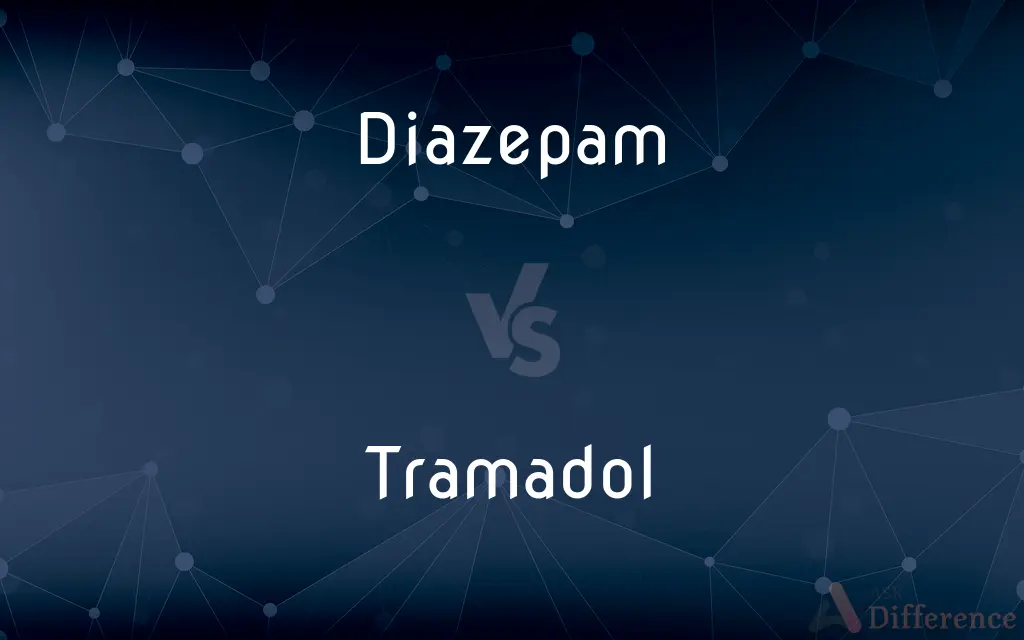Diazepam vs. Tramadol — What's the Difference?
Edited by Tayyaba Rehman — By Fiza Rafique — Updated on April 5, 2024
Diazepam, a benzodiazepine, is primarily used for anxiety relief and muscle relaxation, while Tramadol, an opioid analgesic, is prescribed for moderate to severe pain management.

Difference Between Diazepam and Tramadol
Table of Contents
ADVERTISEMENT
Key Differences
Diazepam acts on the central nervous system by enhancing the effect of the neurotransmitter GABA, leading to sedation, decreased anxiety, and muscle relaxation. Tramadol works by binding to opioid receptors in the brain, altering the perception of pain, and also inhibits the reuptake of serotonin and norepinephrine, contributing to its pain-relieving effects.
While Diazepam is commonly prescribed for anxiety disorders, alcohol withdrawal symptoms, muscle spasms, and as a sedative before medical procedures, Tramadol is used to treat moderate to severe pain, such as that experienced after surgery or in chronic conditions like arthritis. This difference in use reflects their distinct mechanisms of action and therapeutic goals.
Diazepam can cause side effects such as drowsiness, fatigue, and muscle weakness, and it has a potential for dependence and withdrawal symptoms with long-term use. Tramadol's side effects include nausea, dizziness, constipation, and headache, and it also carries a risk of addiction, dependence, and withdrawal, potentially more pronounced due to its opioid nature.
Patients taking Diazepam are advised against operating heavy machinery or driving due to its sedative effects, and similar cautions apply to Tramadol because of its potential to impair judgment and reaction times. Both medications also interact with alcohol and other CNS depressants in ways that can enhance sedative and depressive effects.
Both Diazepam and Tramadol require careful prescription and monitoring due to their potential for abuse and dependence. However, Tramadol's classification as an opioid means it is subject to stricter regulatory controls in many countries, reflecting concerns over the opioid epidemic and the risks of opioid pain relievers.
ADVERTISEMENT
Comparison Chart
Classification
Benzodiazepine
Opioid analgesic
Primary Use
Anxiety relief, muscle relaxation
Pain relief
Mechanism of Action
Enhances GABA neurotransmitter
Binds to opioid receptors, inhibits serotonin and norepinephrine reuptake
Common Side Effects
Drowsiness, fatigue, muscle weakness
Nausea, dizziness, constipation
Risk of Dependence
Yes, with long-term use
Yes, potentially higher due to opioid nature
Regulatory Control
Less stringent than opioids
Subject to strict regulations due to opioid crisis
Interactions
Alcohol, CNS depressants
Alcohol, CNS depressants, certain antidepressants
Compare with Definitions
Diazepam
A benzodiazepine used for anxiety and muscle relaxation.
Diazepam was prescribed to help manage her anxiety symptoms.
Tramadol
An opioid analgesic for moderate to severe pain.
Tramadol was prescribed for her post-surgery pain.
Diazepam
Has potential for dependence with long-term use.
He was carefully monitored to avoid diazepam dependence.
Tramadol
Works by binding to opioid receptors and inhibiting neurotransmitter reuptake.
To control his chronic pain, tramadol was an effective choice.
Diazepam
Interacts with alcohol and CNS depressants.
She was advised not to drink alcohol while taking diazepam.
Tramadol
Subject to strict regulations due to opioid nature.
The prescription for tramadol was carefully regulated to prevent misuse.
Diazepam
Acts by enhancing GABA in the CNS.
To relax his muscle spasms, diazepam was administered.
Tramadol
May cause nausea and dizziness as side effects.
After taking tramadol, she experienced some dizziness.
Diazepam
Can be used as a sedative before procedures.
Before the dental surgery, diazepam was given for sedation.
Tramadol
Carries a risk of addiction and dependence.
His treatment plan included measures to minimize tramadol dependence.
Diazepam
Diazepam, first marketed as Valium, is a medicine of the benzodiazepine family that acts as an anxiolytic. It is commonly used to treat a range of conditions, including anxiety, seizures, alcohol withdrawal syndrome, benzodiazepine withdrawal syndrome, muscle spasms, insomnia, and restless legs syndrome.
Tramadol
Tramadol, sold under the brand name Ultram among others, is an opioid pain medication used to treat moderate to moderately severe pain. When taken by mouth in an immediate-release formulation, the onset of pain relief usually begins within an hour.
Diazepam
A benzodiazepine drug, C16H13ClN2O, used to treat anxiety and alcohol withdrawal and as a sedative, skeletal muscle relaxant, and anticonvulsant.
Tramadol
A synthetic analgesic, C16H25NO2, used in its hydrochloride form to treat moderate to moderately severe pain. It is structurally similar to codeine and has both opioid and nonopioid effects.
Diazepam
(pharmaceutical drug) A tranquilizing muscle relaxant drug (trademark Valium) used chiefly to relieve anxiety.
Tramadol
(pharmaceutical drug) A synthetic opioid analgesic administered orally in the form of its hydrochloride C16H25NO2·HCl to treat moderate to severe pain.
Diazepam
A tranquilizer (trade name Valium) used to relieve anxiety and relax muscles; acts by enhancing the inhibitory actions of the neurotransmitter GABA; can also be used as an anticonvulsant drug in cases of nerve agent poisoning
Common Curiosities
Is Tramadol safer than other opioids?
While Tramadol is often perceived as safer due to its lower potency, it still carries risks of addiction, dependence, and withdrawal, similar to other opioids.
What is Diazepam used for?
Diazepam is used to treat anxiety, relieve muscle spasms, manage alcohol withdrawal symptoms, and as a sedative before medical procedures.
Can Diazepam and Tramadol be taken together?
Combining Diazepam and Tramadol can increase the risk of side effects like drowsiness and respiratory depression; they should only be taken together under strict medical supervision.
Can Diazepam be used for pain relief?
Diazepam is not primarily used for pain relief; its main uses include anxiety reduction and muscle relaxation.
Is Tramadol effective for all types of pain?
Tramadol is effective for moderate to severe pain but may not be suitable for all types of pain, especially pain that responds better to non-opioid treatment strategies.
How does Tramadol relieve pain?
Tramadol relieves pain by binding to opioid receptors in the brain, changing the body's perception of pain, and inhibiting the reuptake of serotonin and norepinephrine.
How are Diazepam and Tramadol regulated?
Diazepam is regulated as a benzodiazepine with potential for abuse, but Tramadol is subject to stricter controls due to its classification as an opioid, reflecting the higher risk of addiction.
What should be avoided while taking Diazepam or Tramadol?
While taking either medication, it's important to avoid alcohol, CNS depressants, and any other substances that the prescribing doctor indicates could interact with the medication.
How long does it take for Diazepam to work?
Diazepam typically begins to work within 30 minutes to an hour, with effects lasting several hours, depending on the dose and individual metabolism.
What are the risks of long-term Diazepam use?
Long-term use of Diazepam can lead to dependence, tolerance, and withdrawal symptoms upon discontinuation.
What happens if you suddenly stop taking Tramadol?
Suddenly stopping Tramadol can lead to withdrawal symptoms such as anxiety, sweating, nausea, muscle aches, and insomnia, so it should be tapered off under medical guidance.
Who should not take Tramadol?
Individuals with certain conditions like uncontrolled epilepsy, severe respiratory depression, or a history of opioid addiction should avoid Tramadol, among others as determined by a healthcare provider.
How does alcohol interact with Diazepam and Tramadol?
Alcohol can enhance the sedative effects of both Diazepam and Tramadol, increasing the risk of drowsiness, respiratory depression, and potentially fatal overdose.
Are there alternatives to Diazepam and Tramadol for anxiety and pain management?
Yes, there are alternatives for both conditions, including other medications, therapy, and lifestyle changes, which should be discussed with a healthcare provider.
Can Diazepam affect memory?
Diazepam can affect short-term memory, especially at higher doses or when used over a long period.
Share Your Discovery

Previous Comparison
Ann vs. Anne
Next Comparison
Approval vs. AccordAuthor Spotlight
Written by
Fiza RafiqueFiza Rafique is a skilled content writer at AskDifference.com, where she meticulously refines and enhances written pieces. Drawing from her vast editorial expertise, Fiza ensures clarity, accuracy, and precision in every article. Passionate about language, she continually seeks to elevate the quality of content for readers worldwide.
Edited by
Tayyaba RehmanTayyaba Rehman is a distinguished writer, currently serving as a primary contributor to askdifference.com. As a researcher in semantics and etymology, Tayyaba's passion for the complexity of languages and their distinctions has found a perfect home on the platform. Tayyaba delves into the intricacies of language, distinguishing between commonly confused words and phrases, thereby providing clarity for readers worldwide.
















































